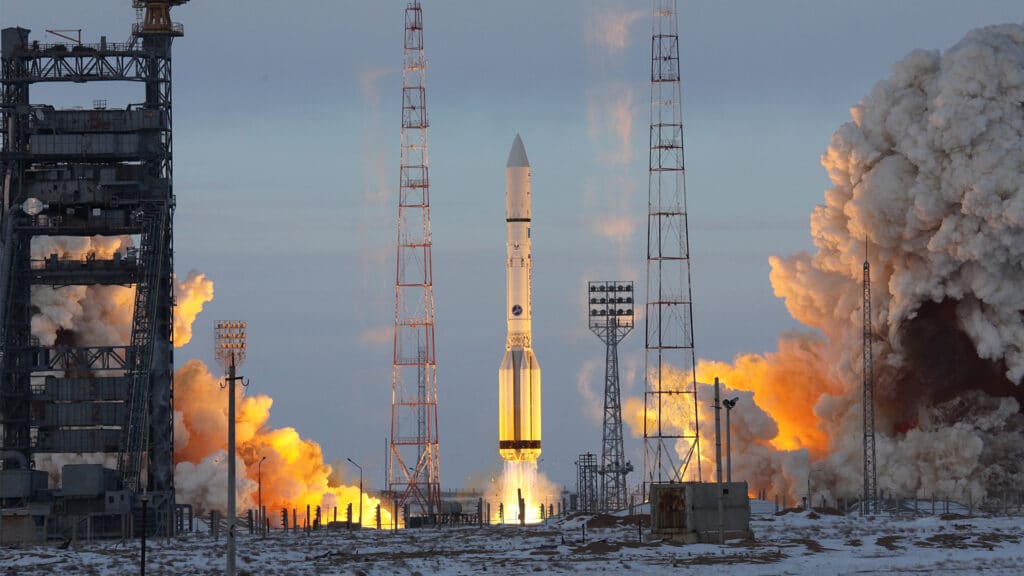Kazakhstan to launch up to 10 Russian toxic rockets by 2026 from Baikonur

According to Kazakhstan’s Vice-Minister of Digital Development Malik Olzhabekov, Russia and Kazakhstan are negotiating the extension of Proton-M expendable launch vehicle (ELV) launches, which are powered by toxic fuel, from the Baikonur Cosmodrome. The official noted that Russia still possesses 10 such ELVs, which it is supposed to launch by the end of 2026 but is very likely to fail to do so. Some earlier media reports suggested that launches of this type of rocket might not proceed after 2025.
«Let me be honest — there are 10 Proton-M vehicles remaining. At the current launch rate, we risk not being able to complete their deployment before 2026. Our partners have proposed extending the deadlines, which makes sense because when we negotiated the launches, we agreed on a specific number of Proton launches, as these vehicles are no longer in production,» Olzhabekov explained.
He emphasized that the launch rate has significantly declined at Baikonur due to geopolitical changes and sanctions. However, if all 10 ELVs are successfully launched by 2026, there will be no need to extend the deadlines.
«The reasoning is that the number of vehicles doesn’t change, but the launch deadlines extend. However, as of now, we have no definitive solution. If we don’t manage to launch the remaining vehicles, the issue will stay pending. I believe we still have time to make a well-considered decision,» he added.
According to Olzhabekov, Kazakhstan is exploring ways to generate economic benefits from each launch beyond the initial deadline. He noted that the Baikonur Cosmodrome currently conducts an average of seven to nine launches annually, with approximately seven launches dedicated to Soyuz ELV missions under the International Space Station (ISS) program and the remaining one or two Proton launches. However, he emphasized that the current arrangement does not provide direct income from the launches themselves, aside from the rental fees.
«One option under discussion is to involve Kazakhstan in the economic value of the launches. For example, Kazakhstan could perform certain works for remuneration. Adjusting the arrangement in this way could strengthen our interest in continuing these launches,» Olzhabekov said.
Why have Russia and Kazakhstan agreed to give up on the Proton launches?
The Proton heavy ELV was developed between 1961 and 1967 and has been widely regarded as the most powerful Russian vehicle. It is fueled by unsymmetrical dimethylhydrazine, also known as heptyl, a highly toxic substance that poses significant hazards to both the environment and human health.
The Baikonur Cosmodrome is the only spaceport designed for launches of this rocket type. Throughout its history, 404 launches have been carried out, 49 of which ended in failure. According to open sources, 13 major accidents involving the Proton rocket have occurred since 1991.
In 1999, the ELV experienced two failures in the Karaganda region. In the first incident, the rocket collapsed and fragments fell into a residential area, causing a fire due to fuel spillage. In the second, debris landed in a sparsely populated area. No casualties were reported, but following these incidents, Kazakhstan demanded a review of the spaceport rental terms.
In 2007, a Proton-M rocket fell 40 kilometers from Zhezkazgan on the same day that former President Nursultan Nazarbayev was in town. Although the damages from the accident were quickly addressed, Kazakhstan claimed $60.7 million in compensation from Russia. However, the amount was later reduced to $2.5 million.
The ELV experienced a series of accidents between 2013 and 2015. In one incident, a rocket crashed just 2.5 kilometers from the launch site while carrying approximately 600 tons of fuel. Following this, Russia and Kazakhstan agreed to terminate Proton launches, with Russia committing to fully replace the Proton with the eco-friendlier Angara ELVs.
However, in April, Russia offered Kazakhstan to continue launching the Proton ELVs. At that time, Kazakhstan’s Ministry of Digital Development considered the offer profitable. However, in June, Olzhabekov stated that the agency plans to review the terms of the agreement.
In early December, MP Aidos Sarym expressed the view that Kazakhstan’s authorities are exploring alternative options for continuing launches, as they are concerned about the potential negative impact on the region’s economy.

